That black sandblasting sand will look amazing under your aquatic plants, right? But is Black Diamond blasting sand planted tank-safe? What about your fish? The media’s used for polishing, after all, wouldn’t it be too sharp? Can it hurt your bottom-dwellers?

So is using Black Diamond blasting sand in a fish tank safe?
Black Diamond blasting sand is made from a coal-burning byproduct called coal slag.
When coal melts, it produces a slag which forms angular granules of varying sizes once it cools down.
These granules then get dried, crushed, and sorted into seven different grades of blasting sand.
Though the BD abrasive media’s main purpose is to be used in the process of sandblasting it will not be harmful to your fish. Here’s why using Black Diamond blasting sand in an aquarium is safe:
This blasting media is completely inert and won’t release any harmful substances in an aquarium. In general, it is as sharp as any other sand, as hardness is important in sandblasting and not having sharp edges. It will not hurt your bottom-dwelling fish. In conclusion, the Black Diamond blasting sand is completely safe for fish tank use.
With that out of the way, we can answer the important questions.
Advantages of using black blasting sand in your aquascape?
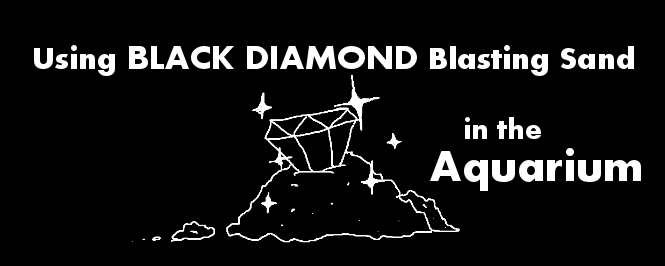
Here are some pros to using the black sandblasting media as aquarium sand, that I’ve found to stand out:
It’s really cheap.
A bag that costs as much as two burgers will supply you with around 50 lbs of black aquarium sand.
It can be a great solution for larger fish tanks on a budget.
My experience has been that with a whole bag of this type of sand which is roughly 50 lbs, I could properly fill a 20-gallon tank.
That’s a 24″ x 12″ (L x W) tank and not the long one, capping at around 3 inches of substrate.
From here on you can do the calculations on your own.
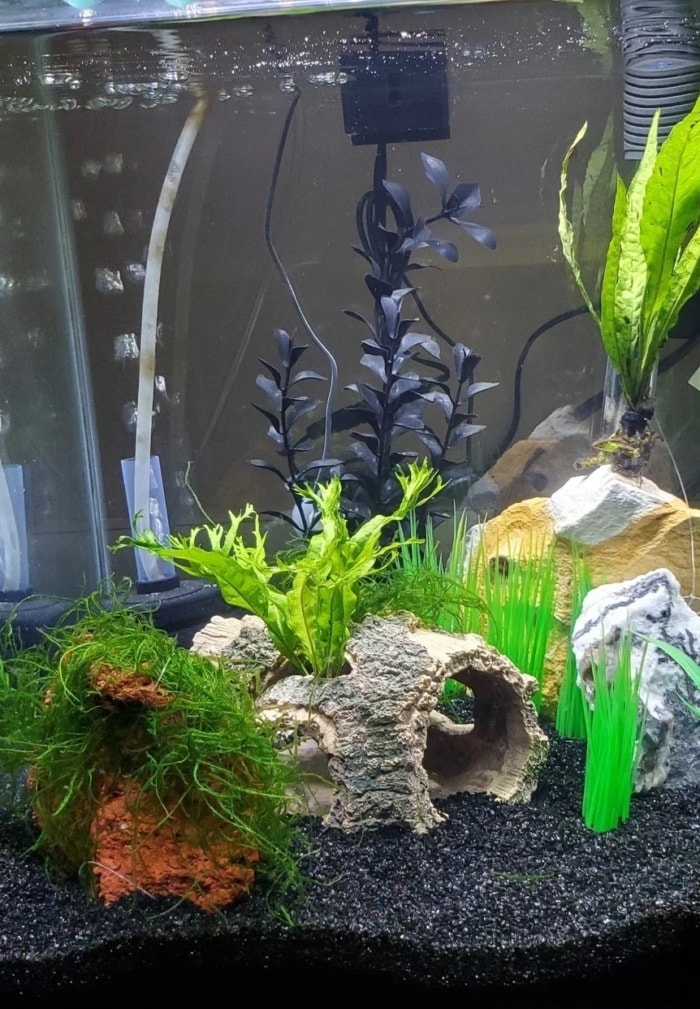
On a 55 gallon tank, you’d need close to 3 full BDBS bags.
That’s as much as “6 burgers” total for a substrate, that would otherwise cost you around 26 burgers.
As a sane person, I would choose to cut the cost of the extra 20 burgers any day.
But the cost is not everything, right?
What I like about this product is its magnificent looks, plain and simple.
It’s not jet black, but it is as black as any aquarium-grade black sand would be.
Upon closer inspection, you may find that it has an amber-ish hue.
Not at all a problem, only your fish that like to hang out on the bottom will notice that anyway. Speaking of which…
Exactly how safe is it for fish?

The Black Diamond blasting sand is absolutely safe for bottom-dwellers. Even the ones with sensitive bellies, such as corydoras and most of the tiny pleco species.
Fish that don’t explicitly “touch” the substrate, but swim very close it like the freshwater shark-lookalikes would also be safe with this type of sand in their tanks. Here’s how I found that out:
I admit that I was concerned before getting a rubber-lipped pleco to test it with. Some people from the on and offline community were saying the blasting sand was too sharp.
“It will hurt your bottom feeders” they said.
“Long-finned fish are in danger around it” they said.
Well, I did a lot more research only to find out that first-hand users would never encounter these problems.
After repeatedly using it myself, I can only assume the well-meaning but misleading warnings came from people who never tried the stuff.
How come Black Diamond Blasting Sand is not sharp though?
The myth that sharp sand is needed for effective sandblasting persisted until the beginning of the 20th century.
Keep in mind that, sharp blasting media can only be obtained through crushing crystals.
At the beginning of the 1900s, experiments have been done to show that blasting media with sharp edges would quickly turn into crystalline dust with no abrasive power.
In fact, sand that contains more than 1% of sharp-edged materials such as silica is forbidden to use in sandblasting, because the crystalline dust may cause Silicosis (a deadly lung disease). You can read more about why sharpness is not what makes blasting sand effective in Popular Science’s issue from February 1919, Little Grains of Sand.
Anyway, I have been relying on Black Diamond sand for nearly eleven years.
My plecos are happy and healthy.
They have been living on that substrate ever since they were little.
All in good shape and to no ill effect.
Also, I’ve personally seen black diamond blasting sand work in aquariums with corydoras that have grown on that substrate.
I’ve not kept corydoras fish in a system with BDBS but having seen it work in other people’s mature tanks and having read multiple reports of Cory keepers I can conclude that it’s safe for fish with tender bellies.
My research showed that Black Diamond Sand can even be used in aquariums with fish that like to burrow themselves in the substrate, such as freshwater eels.
For the sake of transparency: There are some reports of the sandblasting substrate slightly altering the pH in the aquarium.
However, in my experience, this is likely due to human error or other factors that were not related to BDBS, because I – and the large majority of other users – have never experienced changes in PH after using this substrate in an aquarium.
Can it be used in a saltwater tank?
The Black Diamond blasting abrasive is absolutely safe for use in a marine fish tank. It is completely inert which makes it harmless to otherwise sensitive marine life.
I have not run a saltwater tank with it, but I know real-life people from my community who have. And for the record, some of the reef tanks that used BDBS had sand-sifting gobies in them (no ill effect on the fish).
I know how expensive maintaining a reef tank can be.
I was planning on starting one and really wanted it to have a beautiful black substrate.
Back then I already was using the sand for a couple of my freshwater aquariums.
Fortunately, a friend of mine turned out to be brave enough to test it in his small reef tank.
To this day he has been using it in more than one of his marine tanks.
He praises it as his favorite substrate.
Corals and fish alike seem to agree.

The black sand turned out to have a nice unobtrusive glitter under the blue-ish lighting too. It also definitely made the more colorful fish in the tanks pop out more.
Though I ended up going with another substrate for my reef tank (unexpected financial boost), I wouldn’t hesitate to use it for a new reef setup today.
How to prepare blasting sand before using it in the aquarium?

Generally, this type of sand needs a bit of rinsing, but it’s not entirely necessary.
It will release some oil upon washing.
The oil won’t harm your plants or fish, but it will cloud your aquarium water.
Rinsing it with hot water, however, will help to remove it faster.
I prefer to do this in my bathroom, as it creates less mess.
I use some sort of non-powdered latex gloves as protective gear while stirring it.
The reason I do so is that It may get under your fingernails.
This is not a major inconvenience, but it’s not pleasant as well, especially with a finer grit.
If you do choose the bathroom approach – clean the residue from your bathtub after.
Do not use soap in the rising as I have seen some fishkeepers advise online.
Presumably, it will take care of the extra oily stuff that comes off the sand.
Not needed.
Soap is toxic to fish.
I have never had issues when simply rinsing it with hot water.
Even if some oil gets left behind it will accumulate on the water surface.
From there, you can remove it with a rag.
It will stop leaking in no more than a couple of water changes if this is the case.
Nothing to worry about, in my experience.
You can even use it without rinsing, the oil slicks won’t hurt anyone.
In fact, the last time I went with it, I poured the sand media directly into my new tank.
Filled with water and waited for the oil to find its way up the water surface.
Removed it with a cheesecloth (I think) and did not have any issues after.
Although it is extremely rare, some aquarists report finding tiny metal bits in their blasting sand.
Even though I haven’t experienced this, I wouldn’t completely write it off as a possibility.
According to BDBS’s manufacturer, the coal slag they use to create their abrasive products contains between 5 to 12% iron oxide. So there’s a small chance that some of it might end up in the final product.
Especially in the coarse blasting sand grades, where it’s easy for larger particles to pass through the filtering media.
Due to these concerns, I recommend you run a magnet through the BDBS after you rinse it.
This should take care of any metal bits that may eventually be present.
Extra conspiracy-busting tip: The bag will say not to allow the BD black sand to get wet, but that should not scare you.
It is meant to be used as a blasting media.
To properly function as such it should remain dry, as there are other media that are used in wet abrasive blasting.
BDBS is completely inert when wet, however.
What grit of blasting abrasive to use in your aquarium setup?
In general, I’d recommend going for the medium to coarse Black Diamond blasting grit of 20/40.

If you want to have bigger fish in your black sand aquarium, they may cause the finer grit to cloud your water.
This sand is heavier than a regular one so it will dissipate faster when disturbed.
If you plan on using it in reef tanks where a bottom current is often needed – use the medium grade one.
If you do go for the finer 30/60 grit in a freshwater setup, you will have a really easy time planting plants. It will hold them down wonderfully.
Additionally, there’s less of a chance of any metal bits ending up in it since it undergoes a better screen process.
Author’s note: Too fine of a grit may become a little difficult to vacuum.
How suitable is BD’s blasting sand for a planted tank?
This sand has the ability to hold down your plants stably, even compared to other substrates designed for plant growth.
I guess it’s not surprising that I listed it at #3 when discussing the best aquarium substrates for tanks with live plants in them. Click the link to read my full disclosure on the matter with the pros and cons listed.
Anyway, this aquarium-friendly sand is dense, but not prone to compacting, which makes planting in it is a breeze.
You’d need to provide food for the plants’ root systems, however.
Feeding the roots with root tabs has been a success for me.
Any grade of food tablets would do. I use these (link to check them out on Amazon).
For all of you who already think that this can be too much work – I beg to differ.
A single tab will last you months.
Place one for every diameter of 10 inches around each plant bunch and check on the tabs in 3 months.
For heavily planted tanks, you can still use quality soil substrate and top it off with the blasting abrasive.
But what about plants that would fare well in Black Diamond sand?
Well, in general, these would be the plants that would do well in any kind of aquarium sand.
Here’s a few examples you can research further:
- Limnophila sessiliflora
- Hygrophilia difformis
- Cardamine lyrata
- Hygrophila corymbosa
To see the rest of the list along with photos and descriptions of each plant you can visit my article on aquarium plants that grow well in a sandy substrate.
Black Diamond vs Black Beauty?
Both are advertised as blasting sand abrasives, but is there any difference?
The Black Beauty sand is supposedly the same as the Black Diamond.
You can use both in an aquarium to the same effect.
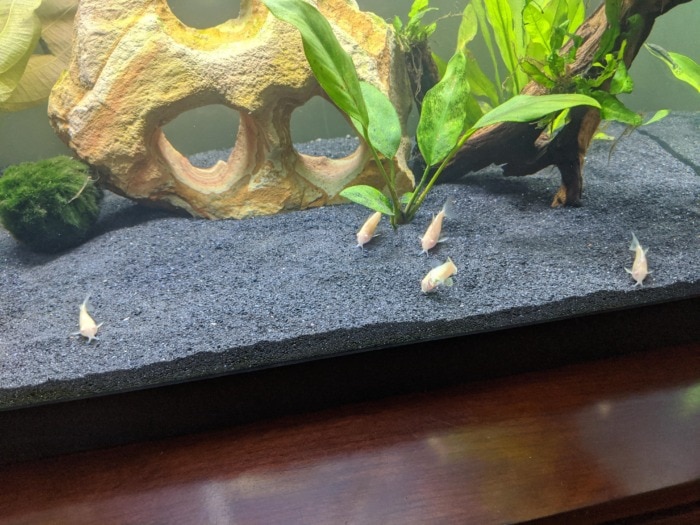
Though they may not have completely identical compositions, they are suitable for aquarium use.
I have not used Black Beauty in my tanks, but there are enough reports of people who had success with it.
The reason fishkeepers may need to use one over the other is often location and availability.
Where to get Black blasting sand?
You can get the Black Diamond sand in any of the “Tractor Supply Co” stores near you.
There you can find 50lb bags at a price of [whatever two burgers cost nowadays].
However, not everyone has one of those in close proximity.
Locate where your nearest store is and calculate how far you’d have to drive to get there.
If you’re okay with the road trip and spending a little money on gas then go for it.
Sometimes we don’t have the time or the chance to take a road trip though. In this case, you can order it online (Amazon has it) but it will cost you around a bit more for a 50lbs bag.
Unfortunately, there it is 5 times the price of the Tractor Supply’s offered bags.
Still, if you have no other option, but want to go for that stunning black look, I think it may be worth the purchase.
A black sand substrate “made for aquariums” such as Tahitian Moon will still cost you around between 5 and 7 times more per bag (be it online or on-site).
Worst case scenario you’d still save the cost of maybe 4 burgers a bag.
Another option is to check if you have a nearby supplier of Black Beauty.
You may also be able to find the black sandblasting media at Lowes or Home Depot where it will still be reasonably overpriced.
My Conclusion
The Black Diamond sand is a livestock-safe aquarium substrate.
It is absurdly cheap while giving unique aesthetics to your fish tank.
You won’t go back to normal substrates after using it.
Do leave a comment below if you feel you need more answers!

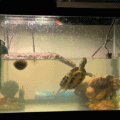


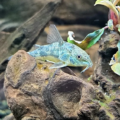
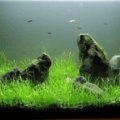
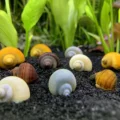

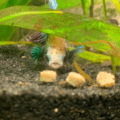
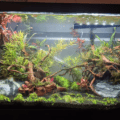
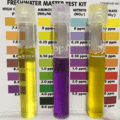
Is this stuff ok to put directly on the glass on the bottom of the tank? I ask because somewhere I saw someone say it need a liner of some kind. Just don’t want to damage the tank. Thank you
Hi Bobbie,
You can’t go wrong with a liner to be honest.
That being said, I have put it on a bare bottom aquarium without issues.
Regards
For a 100 gal tank 2”-3” deep this seems real heavy. Too heavy?
Hi, that’s true, but a 100 gal tank should definitely have a solid stand anyway.
Regards
I am lucky enough to have a Tractor Supply close to me and it is less than 10.00 for a fifty pound bag. It looks gorgeous in my 20 gallon tank. I used fertilizer tabs in the planted tank. My catfish and snails love the stuff. I highly recommend it.It does take a while to clean the oil out, but unlike other substrates I have used it cleared up much faster.
Hey everyone, I’ve been looking all over for where I can get some of this stuff but everything I find won’t ship to where I live, I’m located in Australia Gold Coast and I was wondering if anyone one could paste a link that sells to my area. I could go to a local pet shop to get some aquarium sand but it sells for like AUD $50 for a 15 kilo bag which is way out of my price range- I need about 25 kilos if not more, currently I have gravel and one of my Corydoras got gravel lodged in her throat- she passed away this afternoon as I could not do anything to help it- anyway it’s all good if no one can help, but if you know of somewhere I could get some it would be greatly appreciated
BD blasting service Nerang
Did you have any luck Sam ?
I`m in the same boat , so to speak , but in SA .
Tahitian Moon sand is actually all crushed metal and will slowly poison your fish and inhabitants. Hovering a magnet over it will prove that it is metal. make sure any sand you use is not crushed metal using this method of testing. In a very well planted tank, the plants will act as a filter for the toxic metals but over a few years, it will shorten the lifespan of the fish. Just a heads up.
Thanks for the heads up, man.
Thankfully, I never used that one.
Take care.
Your magnet test doesn’t mean anything as blasting sand is also magnetic and safe.
I just used some Black Diamond sand last night for my new 40 gallon tank! I love the way it looks and was super easy to clean and put in the aquarium. I have not put any fish in, yet, but I can’t wait to see some fish swimming around in with it.
I am also happy to hear that planting will work with this stuff! I was wondering whether it would work or not, but I am definitely going to get some plants and see for myself.
Thanks for the article! I am glad I stumbled upon it!
Hey Corey,
BDBS is one of the best things as a freshwater aquarium substrate, for me personally.
Glad the article helped you.
Quick question about Black Diamond.. just got a bag from a friend who bought it for me over the border in WA state (no BD in Canada) but did not tell him which grade specifically to buy.. so now I got this bag but it does NOT say is it fine or medium coarse on it.. is there a way to find out which one I got like a serial number or?.. thx
Hi, optionmaster!
I don’t know what your bag looks like, but… The granules’ grade should be printed on the outer bottom of the bag (20/40, 30/60 etc.)
At least that’s how it is on mine.
Hope this helps?
Ok now I have mixed feelings about BDBS. On fishlore I read about someone complaining they got cuts on their hand rinsing this stuff so she wouldn’t use it.
Hi Connie,
It can get under your nails, but cut? I highly doubt it. Perhaps, she was using some alternative. I’ve had the stuff for a long time in my aquariums, I have bottom feeders and all…
Hope this clarifies things for you.
I use it in 7 of my tanks… i had washed it without gloves and i have thin eczema prone skin on my hands…, i stirred it and washed 2 bags of it with 0 cuts,… after 20 min or so did get some stuck under my finger nails so then started using a stick.i have Corys/Plecos/bettas/guppies etc. and none of them have cuts or damage:) i highly recommend it!
May I ask which one you got 20/40 or 30/60 For Bottom feeder …I have Corys & pelco to But I think if they could handle the gravel I have now .. the can handle BDBS
I got the 30/60 but if they can handle the 20|40 ..I like The look Of that One better Then One I got
the sells person showed me a sample of each one .. the 30/60 was more powder like 20/40 has shine real pretty out of the water …
I would like to return the one I got and get 20/40 If i can and if it would work for the Corys and pelco .. I
have not open it yet
I use it all the time and use no gloves. Someone being dramatic most likely.
No, i prepared 5 bags of it in scalding water…never had a cut during the wash. Have my planted 180gall full of BDSS iron sillicate. So far all good. Will come back in a year or so and update my review. The 20/40 is quite fine..was actually hopping it would be more coarse so it will not compact.
Thank you for this article! It was really helpful and helped me with making my decision. So I’m thinking maybe it wouldn’t be a bad idea if I wanted a couple heavy root feeders I could maybe even use Aquasoil in just those areas and cap with BD? I’m leery about altering the water chemistry too much. Stability is important to me. One last question…in using DB would you have any problem with the toxic pockets building being this is a coarser sand?
You can use aqua soil and top it off. Root tabs are always an option, though, nothing complicated there.
On your last question: No, I wouldn’t say so. I’m not having such issues with mine, at least. It’s not that coarse, really.
Hope this helps!
You wrote that 20/40 grit is finer than 30/60, but isn’t it the other way around?
Hi Kenny,
Thanks for catching it – you’re actually correct! Fixed that one, cheers!